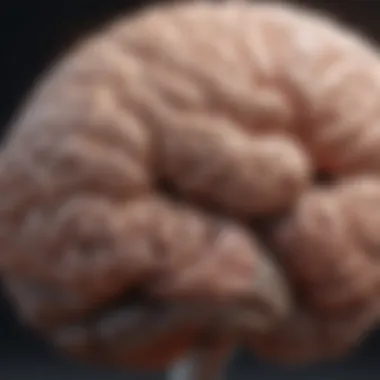Effective Strategies for Managing Public Anxiety


Intro
Public anxiety affects individuals in multiple ways, impacting day-to-day life and overall wellness. Understanding its roots is crucial for effective management. Many people feel overwhelmed in social situations, which can lead to humiliation and avoidance. It is essential to address this issue directly.
Key Benefits
Managing public anxiety brings not only immediate relief but also long-term health benefits. Let’s break down the key advantages of using effective strategies.
Physical Health Benefits
- Reduces stress levels: Effective anxiety management techniques lower cortisol production, leading to overall better physical health.
- Enhances resilience: Building resilience through healthy coping strategies makes individuals less prone to physical symptoms related to anxiety.
- Improves sleep quality: Managing anxiety can lead to better sleep patterns, resulting in enhanced physical health.
Mental Well-being Enhancements
- Boosts self-esteem: Developing effective management strategies enhances confidence in social situations.
- Promotes emotional regulation: Learning to cope with anxiety equips individuals to handle different emotional states better.
- Fosters a sense of connection: Utilizing social support reduces feelings of isolation, improving mental health.
"Managing public anxiety effectively leads to a more fulfilling life, as individuals gain confidence and resilience."
Practical Tips
Cognitive Techniques
To manage public anxiety, cognitive restructuring is critical. Changing negative thought patterns enables one to approach social interactions with an open mind. This process can include:
- Identifying negative thoughts.
- Challenging irrational beliefs.
- Replacing them with constructive views.
Behavioral Techniques
Behavioral strategies can help modify responses to anxiety-provoking situations. Gradual exposure is a key approach:
- Start small by facing low-stress social interactions.
- Progressively expose yourself to more challenging situations as you build confidence.
- Celebrate small victories to reinforce positive experiences.
Social Support
Connecting with others can mitigate feelings of anxiety. Consider:
- Sharing experiences with trusted friends or family members.
- Joining support groups to gain insight from those with similar experiences.
- Utilizing social media platforms like Reddit to engage with others tackling similar issues.
Self-reflection
Reflection is vital for growth. Set aside time regularly to:
- Assess your anxiety triggers.
- Observe progress in managing these triggers.
- Adjust techniques as needed to remain aligned with personal goals.
Understanding Public Anxiety
Understanding public anxiety is essential for anyone seeking to navigate social situations with confidence. It serves as a foundation for developing effective strategies to cope with the various forms of anxiety experienced in public settings. This article explores public anxiety's origins, its manifestations, and how it can profoundly affect one’s overall quality of life.
Public anxiety, which is often triggered in crowded spaces or during social interactions, can hinder personal relationships and job performance. Thus, grasping its full scope allows individuals to identify their triggers, recognize their symptoms, and ultimately implement coping mechanisms that work toward mitigation.
Definition and Characteristics
Public anxiety can be defined as the feeling of apprehension or fear associated with specific social situations. It is characterized by physical symptoms such as increased heart rate, sweating, or trembling, along with cognitive symptoms like racing thoughts or excessive worry about being judged. Recognizing these characteristics is crucial since they can vary widely from person to person.
Some common characteristics include:
- Physical symptoms: Shakiness, nausea, and muscle tension.
- Cognitive symptoms: Difficulty concentrating, feelings of embarrassment, or thoughts of inadequacy.
- Behavioral changes: Avoiding social interactions or feeling uncomfortable in gatherings.
Common Triggers
The triggers of public anxiety often stem from situations perceived as intimidating or stressful. Common triggers include:
- Public speaking: Many individuals report anxiety when addressing a group.
- Social gatherings: Events with a large number of people can be overwhelming.
- Networking sessions: The pressure to make connections can induce stress.
- Performance situations: Performing in front of an audience, be it in work or personal life, can amplify anxiety.
It is important for individuals to identify their specific triggers since understanding leads to proactive strategies for management.
Impact on Daily Life
Public anxiety can have a significant impact on daily life. It can affect not only social interactions but also professional opportunities and personal fulfillment. Individuals facing public anxiety are often reluctant to engage in activities that require social involvement. This can lead to isolation and a sense of hopelessness. The repercussions might include:
- Professionally: Reduced career advancements due to fear of networking or meeting new people.
- Socially: Withdrawal from friendships or family obligations can strain relationships.
- Emotionally: Ongoing anxiety might lead to other mental health issues such as depression.


"Public anxiety, when unmanaged, can create obstacles that limit personal and professional growth."
Recognizing the characteristics and triggers of public anxiety is the first step on the path to effective management. With this understanding, individuals can begin to address their concerns and implement strategies that enhance their social experiences.
Identifying Personal Anxiety Patterns
Understanding personal anxiety patterns is crucial to effectively managing public anxiety. It not only aids individuals in recognizing their triggers but also helps them develop coping strategies tailored to their specific needs. Identifying these patterns allows for a more structured approach to anxiety management, underscoring the need for self-awareness and introspection.
Self-Assessment Techniques
Self-assessment is an essential step in identifying personal anxiety patterns. Keeping a journal can be an effective method. Regularly writing about one's thoughts and feelings can reveal recurring themes or triggers impacting anxiety levels. Additionally, individuals can use self-report questionnaires, such as the Generalized Anxiety Disorder 7-item (GAD-7) scale, to better understand their anxiety.
Some important techniques include:
- Daily Mood Tracking: Note fluctuations in mood and physical sensations throughout the day.
- Rating Anxiety Episodes: Score the intensity of anxiety episodes to gauge severity and frequency over time.
- Reflection Questions: Consider what situations or interactions led to anxiety. Evaluating these can unveil underlying patterns.
Recognizing Physical Symptoms
Recognizing physical symptoms of anxiety is crucial for a comprehensive understanding of personal anxiety patterns. Anxiety often manifests through various physical symptoms, such as:
- Increased heart rate
- Sweating or chills
- Muscle tension
- Digestive issues
By becoming aware of these physical responses, individuals can link them to emotional triggers. Body awareness can serve as an early warning system, indicating when anxiety levels begin to rise. Acknowledging these symptoms is the first step toward effective management.
"Self-awareness is the first step to change."
Noticing Thought Patterns
Thought patterns play a vital role in the experience of anxiety. Many individuals might notice a tendency toward negative thinking or catastrophizing situations. Keeping a record of anxious thoughts can help individuals identify cognitive distortions. Common patterns include:
- All-or-Nothing Thinking: Viewing situations in black-and-white terms.
- Catastrophizing: Expecting the worst possible outcome.
- Overgeneralization: Making broad statements based on limited experiences.
To address these thoughts, it is helpful to challenge their validity. Asking oneself whether there is evidence supporting these thoughts can lead to more balanced perspectives. This recognition fosters a pathway to cognitive restructuring, ultimately reducing anxiety.
Cognitive Techniques for Anxiety Management
Cognitive techniques play a pivotal role in managing public anxiety. They empower individuals to understand their thought processes and emotional responses. By identifying and reshaping negative thought patterns, these techniques create pathways for healthier emotional responses. This section outlines the principles of Cognitive Behavioral Therapy, how to challenge negative thoughts, and the process of reframing situations.
Cognitive Behavioral Therapy (CBT) Principles
Cognitive Behavioral Therapy is a structured, goal-oriented therapeutic approach. It operates on the idea that our thoughts, feelings, and behaviors are interconnected. The premise is straightforward – altering negative thought patterns can lead to changed behaviors and improved emotions. CBT provides individuals with tools to identify cognitive distortions and replace them with more rational thoughts.
Benefits of CBT include:
- Improved Emotional Regulation: Individuals learn to recognize the link between thoughts and emotions, allowing better control.
- Problem-Solving Skills: CBT encourages active engagement in problem-solving rather than passive rumination.
- Empowerment: By teaching skills to manage anxiety, individuals feel more competent and capable in addressing their fears.
Considerations for implementing CBT involve a commitment to consistent practice. This may include journaling, practicing thought record techniques, and engaging in therapy sessions.
Challenging Negative Thoughts
Challenging negative thoughts is central to effectively managing anxiety. The first step is to recognize when these thoughts arise. Many individuals may not even realize they are experiencing negative thinking until reflecting on their emotions. Once identified, the next step is to evaluate the validity of these thoughts.
To challenge negative thoughts, consider the following techniques:
- Evidence Gathering: Ask how true the thought is. Look for evidence against it.
- Recognize Cognitive Distortions: Common distortions include catastrophizing, overgeneralization, and black-and-white thinking.
- Replace with Balanced Thoughts: Create a more balanced perspective based on facts rather than fears.
"Challenging negative thoughts is about moving from emotional reasoning to logical reasoning."
This process can take time. However, consistent practice enhances the ability to counteract intrusive negative thoughts, thus reducing overall anxiety levels.
Reframing Situations
Reframing involves changing the way one interprets a situation. This cognitive technique shifts perspective from a negative view to a more positive or neutral one. For instance, seeing a public speaking engagement not as a source of fear but as an opportunity to share knowledge can alleviate anxiety.
Techniques for effective reframing include:
- Identifying Presumed Threats: List out fears related to a situation. Analyzing them can often reveal their irrational basis.
- Shifting Focus: Instead of concentrating on potential failures, focus on possible positive outcomes.
- Exploring Alternative Outcomes: Consider various scenarios that might occur instead of the worst-case scenario.
Implementing reframing effectively can lead to reduced anxiety responses and promote a sense of control. By consciously choosing to adopt alternative viewpoints, individuals can alleviate feelings of helplessness in anxiety-provoking situations.
Behavioral Strategies to Cope with Anxiety
A range of behavioral strategies exist for managing public anxiety effectively. Thes techniques are not only practical, but they also allow individuals to gain control over their anxiety responses when facing everyday social situations. Recognizing that anxiety often stems from behavioral patterns makes it crucial to address these in treatment plans. By actively engaging in specific strategies, people can diminish their anxiety levels, promote emotional resilience, and achieve a greater sense of well-being.


Exposure Therapy Basics
Exposure therapy rests on the principle of confronting fears in a controlled manner. This method involves gradually introducing a person to their sources of anxiety. It can range from imagining a daunting social scenario to actually participating in such situations. The primary goal is to reduce the fear response over time. For instance, someone afraid of public speaking might first practice speaking in front of a mirror, then to a friend, and eventually to a larger group.
Key Benefits of Exposure Therapy:
- Desensitization: Over time, individuals become less sensitive to their triggers.
- Coping Skills Development: Participants learn to manage their anxiety effectively.
- Increased Confidence: Successfully facing fears can significantly boost self-esteem.
Gradual Desensitization Techniques
Gradual desensitization is a careful approach that involves small steps toward confronting anxiety-inducing scenarios. This process relies on a systematic exposure hierarchy, where individuals rate their fears and gradually expose themselves to these situations. For example, someone who experiences anxiety in crowded places might start by visiting a less crowded area and slowly progress to busier environments.
Stages of Gradual Desensitization:
- Identify Fears: List specific situations that trigger anxiety.
- Create a Hierarchy: Rank these situations from least to most anxiety-provoking.
- Gradual Exposure: Begin with the least anxiety-provoking scenario and gradually work up the hierarchy.
Through this technique, anxiety tends to decrease as individuals encounter feared situations repeatedly and learn that they can cope with the discomfort they evoke.
Mindfulness Practices
Mindfulness practices play an essential role in managing public anxiety. They encompass a variety of techniques that promote present-moment awareness and emotional regulation. Practicing mindfulness helps individuals redirect their focus from anxious thoughts to their surroundings.
Common Mindfulness Techniques:
- Breathing Exercises: Focusing on breath can calm the mind and body, reducing anxiety symptoms.
- Body Scanning: This involves mentally scanning the body to identify tension areas, promoting relaxation.
- Guided Meditation: Listening to meditation scripts or audio can help cultivate awareness.
Mindfulness practices not only reduce anxiety in the moment but can also contribute to long-term emotional resilience by fostering a more profound understanding of personal triggers and responses.
"Mindfulness is not about getting anywhere else; it is about being where you are."
Incorporating these behavioral strategies forms a comprehensive approach to managing public anxiety and can significantly enhance the quality of life for many individuals.
The Role of Social Support
Social support plays a significant role in managing public anxiety. The presence of supportive individuals can help diminish feelings of isolation and fear in anxious situations. People often seek comfort from family, friends, and peers when facing anxiety. This belongingness contributes to emotional and psychological well-being. According to studies, social support can lead to lower levels of stress and better coping mechanisms. It acts as a buffer against the shocks of public anxiety, helping individuals navigate challenging environments with greater ease.
Building a Support Network
Creating a robust support network is vital for effective anxiety management. Individuals should aim to surround themselves with people who understand their struggles. This network may include close friends, family members, or even coworkers.
Involving others in one's anxiety journey can foster an environment of understanding and acceptance. Here are some effective ways to build this network:
- Engage in community activities: Join clubs or groups that resonate with personal interests.
- Utilize social media: Platforms like Facebook can connect individuals to support groups.
- Attend workshops or support meetings: Many local organizations host events focused on mental health support.
A strong support network provides encouragement and validation when anxiety peaks, reminding individuals they are not alone.
Communicating Needs Effectively
Effective communication is essential for establishing a supportive relationship. People often struggle to convey their feelings adequately, which can lead to misunderstandings. Clear communication about anxiety needs can encourage others to offer support
Some essential strategies include:
- Being honest about feelings: Sharing one's emotional state can open dialogues and solicit help from others.
- Using "I" statements: This can express feelings without making others defensive. For example, “I feel anxious when” instead of “You make me feel anxious.”
- Requesting specific help: Suggest what kind of support is needed, whether it’s a listening ear, companionship in social settings, or professional assistance.
This clarity helps in strengthening bonds while ensuring that others know how to assist appropriately.
Seeking Professional Help
Sometimes, personal networks may not be enough to tackle severe anxiety. In such cases, seeking professional help becomes a crucial part of the strategy. Mental health professionals can offer an informed perspective that friends or family may lack.
Several options are available for those considering this path:
- Therapists or counselors: Engaging in therapeutic practices can address deeper issues contributing to anxiety.
- Psychiatrists: They can evaluate any underlying psychiatric conditions and discuss medication options.
- Support groups led by professionals: These provide structured environments to share experiences and gain insights from others facing similar challenges.
While seeking help can be daunting, it is a progressive step towards better mental health. An informed approach can lead to sustainable strategies for managing one’s anxiety effectively.
"Social support is crucial in times of anxiety, providing resources that help individuals cope and thrive." These support systems do not replace the need for personal strategies but significantly enhance the capacity for managing anxiety.
Lifestyle Modifications for Reducing Anxiety
Lifestyle changes can play a critical role in managing public anxiety. They encompass various aspects of daily life, including physical activity, diet, and routine. By modifying these behaviors, individuals can reduce feelings of anxiety and improve their overall mental well-being. This section will delve deeper into the specific strategies that can be implemented and the benefits they offer.


The Importance of Regular Exercise
Regular exercise is essential for maintaining mental health. Engaging in physical activities increases the production of endorphins, the body’s natural mood lifters. These chemicals help reduce stress and promote a sense of well-being. Furthermore, exercise can serve as a healthy distraction from anxiety-provoking thoughts.
Recent studies have shown that even moderate-intensity exercise, such as brisk walking or cycling, can significantly decrease anxiety levels. This is particularly important for those who experience anxiety in social settings, as regular physical activity can enhance confidence and foster social interactions. It's recommended to aim for at least 150 minutes of moderate exercise each week. This can be structured or unstructured; what matters most is consistency.
Nutritional Considerations
Diet can have profound effects on mood and anxiety. Consuming a balanced diet rich in whole foods is crucial. Nutrients like Omega-3 fatty acids, found in fish, and antioxidants, present in fruits and vegetables, are known to have mood-stabilizing properties. On the other hand, processed foods and those high in sugar can lead to fluctuations in energy levels and mood.
Consider integrating the following foods into your diet:
- Leafy greens (e.g., spinach, kale)
- Nuts and seeds (e.g., walnuts, flaxseeds)
- Whole grains (e.g., quinoa, brown rice)
Moreover, hydration plays a significant role too. Dehydration can lead to irritability and decreased concentration, which may exacerbate anxiety. Aiming to stay hydrated can help maintain clarity of thought and emotional stability.
Establishing a Healthy Routine
A well-structured daily routine can provide a sense of stability and predictability, both of which are essential for managing anxiety. When life feels chaotic, anxiety can spike. Setting regular times for waking up, meals, and sleep can help reinforce a productive cycle.
Incorporating relaxation techniques such as meditation, deep breathing exercises, or yoga into the daily routine can also be beneficial. These practices help ground individuals and can serve as effective tools for managing stress in real-time.
Regularly engaging in a structured routine not only improves time management but also promotes a sense of accomplishment and reduces anxiety.
In summary, lifestyle modifications are powerful tools in the fight against anxiety. By recognizing the importance of exercise, nutrition, and routine, individuals can make significant strides toward improving their mental health.
Technological Aids in Anxiety Management
In an increasingly digital world, technological aids offer a unique dimension in addressing public anxiety. They provide accessible methods to manage anxiety in real-time, reducing barriers that might prevent individuals from seeking traditional forms of help. Such tools can be especially beneficial for those who may feel uncomfortable addressing their anxiety in social settings or who are looking for flexible solutions that fit their lifestyles. With 24/7 availability, these solutions are making anxiety management more attainable.
Utilizing Mobile Applications
Mobile applications represent one of the most practical technological advancements in anxiety management. These tools come packed with resources ranging from guided meditations to cognitive behavioral therapy techniques. Popular apps like Headspace and Calm provide mindfulness practices which can be easily integrated into an individual’s daily routine. Users can select notifications to remind them to engage with the content, which helps establish a consistent practice.
Another advantage of mobile apps is their privacy. Individuals can engage with their mental health journey without the fear of social judgment. This feature is crucial for people who experience public anxiety, as the option to seek help discreetly can lower barriers to entry. Many apps offer user support communities, providing a sense of connection without the pressures of face-to-face interaction.
Online Therapy Options
Online therapy has transformed how people seek professional help for anxiety. Platforms like BetterHelp and Talkspace allow individuals to connect with licensed therapists from the comfort of their homes. This method can be particularly effective for those who may feel overwhelmed by the thought of visiting a therapist in person. Online therapy also provides access to a wider range of professionals who specialize in various areas of mental health, allowing users to choose the therapist that best fits their needs.
The flexibility in scheduling appointments with online therapy platforms can cater to different lifestyles. Clients can often communicate with their therapists via text, video, or phone calls—all of which can help eliminate the stress associated with traditional in-person visits. This option is especially beneficial for those balancing work and personal commitments.
Virtual Support Groups
Virtual support groups offer a communal approach to managing public anxiety. They provide a safe space where individuals can share experiences and strategies without the pressures of in-person meetings. Platforms such as Reddit and Facebook host numerous groups centered on anxiety support, where members can engage in discussions that are both supportive and informative.
Participating in these groups can foster a sense of belonging, proving crucial for managing anxiety. Individuals often find comfort in knowing that they are not alone in their struggles. Sharing personal stories, coping techniques, and resources helps to create a collective knowledge base that can be beneficial for group members.
"Virtual support groups can expand one’s network, proving that help can indeed be found anywhere."
When engaging in virtual support groups, it is essential to approach with caution. Readers should ensure they are participating in groups where professionalism and respect are prioritized and avoid misinformation that might arise in less regulated spaces.
In summary, technological aids, such as mobile applications, online therapy, and virtual support groups, are indispensable tools in managing public anxiety. They provide flexibility, privacy, and a sense of community, all of which empower individuals to take an active role in their mental health journey.
Long-Term Strategies for Sustained Improvement
Long-term strategies are essential for addressing public anxiety effectively. These methods not only help individuals manage immediate anxiety but also foster resilience against future instances. Developing a comprehensive approach strengthens mental well-being and enhances the ability to handle situations that induce stress. The focus on sustaining improvement increases the likelihood of making meaningful changes in daily life, rather than relying on temporary fixes.
Setting Realistic Goals
Setting realistic goals is fundamental in mitigating anxiety. Goals should be achievable and measurable, creating a framework for progress. Consider personal strengths and limitations to ensure goals align with individual capacities. For instance, a person may set a goal to attend a public event rather than seeking to become a public speaker overnight. It’s crucial to break larger goals into smaller, more manageable tasks. By achieving these smaller steps, individuals can celebrate progress, which reinforces confidence.
- Define Clarity: Be specific about what you want to achieve.
- Check Progress: Regularly assess performance against the goals.
- Adjust if Needed: Be willing to modify goals based on experiences.
Continuous Self-Reflection
Engaging in continuous self-reflection allows individuals to evaluate their feelings and thoughts consistently. This practice helps in recognizing patterns that lead to anxiety. Reflective journaling is a useful tool; by documenting daily experiences, individuals can identify triggers and responses. With time, it becomes easier to predict and alter reactions to anxiety-inducing situations.
- Scheduled Reflection Time: Set aside moments for introspection.
- Question Assumptions: Challenge preconceived notions about anxiety.
- Focus on Growth: Reflect on successes and setbacks equally to gain balance.
Adapting Strategies to Changing Circumstances
The capacity to adapt is vital in maintaining long-term management of anxiety. Life is variable, and strategies must remain flexible to be effective. Individuals can periodically reassess their coping techniques to ensure they meet current needs. What worked a year ago may no longer suffice. Being open to alternative approaches can enhance adaptability.
- Evaluate Context: Recognize when existing strategies do not work.
- Explore New Techniques: Stay informed about emerging methods in anxiety management.
- Seek Support: Sometimes, professional guidance can aid in finding suitable adaptations.
"Long-term management requires ongoing effort and willingness to evolve strategies to fit new contexts."
By prioritizing these elements, individuals can navigate public anxiety more effectively. They can cultivate a proactive mindset, fostering ongoing improvement and resilience.















